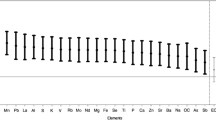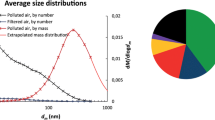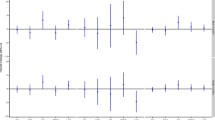Abstract
Associations between exposure to fine particulate matter and blood pressure responses have been reported in epidemiological studies but findings have proven inconsistent. The objective of this study was to measure effects of primary and secondary components of traffic-derived fine particulate matter (PM2.5) on blood pressure (BP). Sprague–Dawley rats were exposed to fresh primary vehicular particles (P), secondary organic aerosol (SOA), photochemically aged primary plus secondary organic aerosols (P + SOA) or filtered air for 5 h per day for three consecutive weeks. Particle concentration target was 50 μg/m3 for all exposures. Blood pressure parameters were measured continuously using implanted transmitters. Systolic (SBP) and diastolic blood pressure (DBP), mean pressure, pulse pressure, and heart rate responses were assessed using mixed effects models. Exposure to P resulted in increased SBP (p = 0.03) and DBP (p = 0.05) that was sustained across weeks. SOA exposure resulted in increases in SBP (p = 0.07) and DBP (p = 0.01) on the first day with this effect decreasing significantly across exposure days (p < 0.0001). P + SOA showed significant increases in SBP (p = 0.002) and DBP (p < 0.0001) across weeks with a magnitude of effect equaling the approximate average of the effect estimates of the P and SOA exposures. Double Sham exposures following SOA and P + SOA showed compensatory decreases in SBP and DBP. No exposure had a significant effect on heart rate. Primary and secondary traffic derived aerosols can substantially increase SBP and DBP, but these increases are lost with continued exposures. Compensatory BP responses resulting after exposure to secondary particles require further investigation to define BP control mechanisms.



Similar content being viewed by others
References
Anderson DE, McNeely JD, Windham BG (2010) Regular slow-breathing exercise effects on blood pressure and breathing patterns at rest. J Hum Hypertens 24:807–813
Anselme F, Loriot S, Henry JP, Dionnet F, Napoleoni JG, Thuillez C, Morin JP (2007) Inhalation of diluted diesel engine emission impacts heart rate variability and arrhythmia occurrence in a rat model of chronic ischemic heart failure. Arch Toxicol 81:299–307
Araujo JA, Nel AE (2009) Particulate matter and atherosclerosis: role of particle size, composition and oxidative stress. Part Fibre Toxicol 6:24
Bartoli CR, Wellenius GA, Coull BA, Akiyama I, Diaz EA, Lawrence J, Okabe K, Verrier RL, Godleski JJ (2009a) Concentrated ambient particles alter myocardial blood flow during acute ischemia in conscious canines. Environ Health Perspect 117:333–337
Bartoli CR, Wellenius GA, Diaz EA, Lawrence J, Coull BA, Akiyama I, Lee LM, Okabe K, Verrier RL, Godleski JJ (2009b) Mechanisms of inhaled fine particulate air pollution-induced arterial blood pressure changes. Environ Health Perspect 117:361–366
Batalha JR, Saldiva PH, Clarke RW, Coull BA, Stearns RC, Lawrence J, Murthy GG, Koutrakis P, Godleski JJ (2002) Concentrated ambient air particles induce vasoconstriction of small pulmonary arteries in rats. Environ Heal Perspect 110:1191–1197
Bell ML, Dominici F, Ebisu K, Zeger SL, Samet JM (2007) Spatial and temporal variation in PM(2.5) chemical composition in the United States for health effects studies. Environ Health Perspect 115:989–995
Brook RD, Rajagopalan S (2009) Particulate matter, air pollution, and blood pressure. J Am Soc Hypertens 3:332–350
Brook RD, Rajagopalan S, Pope CA 3rd, Brook JR, Bhatnagar A, Diez-Roux AV, Holguin F, Hong Y, Luepker RV, Mittleman MA, Peters A, Siscovick D, Smith SC Jr, Whitsel L, Kaufman JD (2010) Particulate matter air pollution and cardiovascular disease: an update to the scientific statement from the American Heart Association. Circulation 121:2331–2378
Cohn JN, McInnes GT, Shepherd AM (2011) Direct-acting vasodilators. J Clin Hypertens (Greenwich) 13:690–692
Coull BA, Wellenius GA, Gonzalez-Flecha B, Diaz E, Koutrakis P, Godleski JJ (2011) The toxicological evaluation of realistic emissions of source aerosols study: statistical methods. Inhal Toxicol 23(Suppl 2):31–41
Delfino RJ, Tjoa T, Gillen DL, Staimer N, Polidori A, Arhami M, Jamner L, Sioutas C, Longhurst J (2010) Traffic-related air pollution and blood pressure in elderly subjects with coronary artery disease. Epidemiology 21:396–404
Diaz EA, Lemos M, Coull B, Long MS, Rohr AC, Ruiz P, Gupta T, Kang CM, Godleski JJ (2011) Toxicological evaluation of realistic emission source aerosols (TERESA)-power plant studies: assessment of breathing pattern. Inhal Toxicol 23(Suppl 2):42–59
Diaz, E. A., Chung, Y., Lamoureux, D. P., Papapostolou, V., Lawrence, J., Long, M., Mazzaro, V., Buonfiglio, H., Sato, R., Koutrakis, P. & Godleski, J. J. 2012. Effects of Fresh and Aged Traffic-Related Particles on Breathing Pattern, Cellular Responses and Oxidative Stress. Air Quality Atmosphere & Health. doi:AIRQ-402
D'Ippoliti D, Forastiere F, Ancona C, Agabiti N, Fusco D, Michelozzi P, Perucci CA (2003) Air pollution and myocardial infarction in Rome: a case-crossover analysis. Epidemiology 14:528–535
Dolinay T, Szilasi M, Liu M, Choi AM (2004) Inhaled carbon monoxide confers antiinflammatory effects against ventilator-induced lung injury. Am J Respir Crit Care Med 170:613–620
Filippone JD, Bisognano JD (2007) Baroreflex stimulation in the treatment of hypertension. Curr Opin Nephrol Hypertens 16:403–408
Fineman JR, Wong J, Soifer SJ (1993) Hyperoxia and alkalosis produce pulmonary vasodilation independent of endothelium-derived nitric oxide in newborn lambs. Pediatr Res 33:341–346
Franklin M, Zeka A, Schwartz J (2007) Association between PM2.5 and all-cause and specific-cause mortality in 27 US communities. J Expo Sci Environ Epidemiol 17:279–287
Gianetti J, Bevilacqua S, de Caterina R (2002) Inhaled nitric oxide: more than a selective pulmonary vasodilator. Eur J Clin Investig 32:628–635
Godleski JJ, Rohr AC, Kang CM, Diaz EA, Ruiz PA, Koutrakis P. (2011) Toxicological evaluation of realistic emission source aerosols (TERESA): introduction and overview. Inhal Toxicol 23 (Suppl 2):1–10
Hagler GSW, Baldauf RW, Thoma ED, Long TR, Snow RF, Kinsey JS, Oudejans L, Gullet BK (2009) Ultrafine particles near a major roadway in Raleigh, North Carolina: downwind attenuation and correlation with traffic-related pollutants. Atmospheric Environment 43:1229–1234
Hitchins J, Morawska L, Wolff R, Gilbert D (2000) Concentrations of sub-micrometer particles from vehicle emissions near a major road. Atmospheric Environment 34:51–59
Hodan, W. M. & Barnard, W. R. (2004) Evaluating the Contribution of PM2.5 Precursor Gases and Re-entrained Road Emissions to Mobile Source PM2.5 Particulate Matter Emissions. MACTEC Federal Programs. Research Triangle Park, NC. http://infohouse.p2ric.org/ref/43/42565.pdf
Kaneko Y, Floras JS, Usui K, Plante J, Tkacova R, Kubo T, Ando S, Bradley TD (2003) Cardiovascular effects of continuous positive airway pressure in patients with heart failure and obstructive sleep apnea. N Engl J Med 348:1233–1241
Kim HP, Ryter SW, Choi AM (2006) CO as a cellular signaling molecule. Annu Rev Pharmacol Toxicol 46:411–449
Kleindienst TE, Lewandowski M, Offenberg JH, Edney EO, Jaoui M, Zheng M, Ding X, Edgerton ES (2010) Contribution of primary and secondary sources to organic aerosol and PM2.5 at SEARCH network sites. J Air Waste Manag Assoc 60:1388–1399
Laden F, Neas LM, Dockery DW, Schwartz J (2000) Association of fine particulate matter from different sources with daily mortality in six U.S. cities. Environ Heal Perspect 108:941–947
Madsen LB, Rasmussen JK, Moller DS, Nyvad O, Pedersen EB (2008) Heart rate variability in white-coat hypertension. Blood Press Monit 13:65–71
Mills NL, Donaldson K, Hadoke PW, Boon NA, Macnee W, Cassee FR, Sandstrom T, Blomberg A, Newby DE (2009) Adverse cardiovascular effects of air pollution. Nat Clin Pract Cardiovasc Med 6:36–44
Morse D, Choi AM (2008) Inhaled CO in the treatment of acute lung injury. American Journal of Physiology Lung Cellular and Molecular Physiology 294:L642–L643
Olschewski H, Olschewski A, Rose F, Schermuly R, Schutte H, Weissmann N, Seeger W, Grimminger F (2001) Physiologic basis for the treatment of pulmonary hypertension. J Lab Clin Med 138:287–297
Otterbein LE, Mantell LL, Choi AM (1999) Carbon monoxide provides protection against hyperoxic lung injury. Am J Physiol 276:L688–L694
Papapostolou, V., Lawrence, J. E., Ferguson, S. T., Wolfson, J. M. & Koutrakis, P. (2012) Development of an Exposure Generation System to Investigate the Health Effects of Fresh and Aged Vehicular Particulate Emissions. Air Quality Atmosphere & Health doi:AIRQ-401
Peters A, Liu E, Verrier RL, Schwartz J, Gold DR, Mittleman M, Baliff J, Oh JA, Allen G, Monahan K, Dockery DW (2000) Air pollution and incidence of cardiac arrhythmia. Epidemiology 11:11–17
Peters A, von Klot S, Heier M, Trentinaglia I, Hormann A, Wichmann HE, Lowel H (2004) Exposure to traffic and the onset of myocardial infarction. N Engl J Med 351:1721–1730
Ryter, S.W., Morse, D. & Choi, A.M. (2004) Carbon monoxide: to boldly go where NO has gone before. Science's STKE: signal transduction knowledge environment 2004(230):RE6
Schwartz J (2001) Is there harvesting in the association of airborne particles with daily deaths and hospital admissions? Epidemiology 12:55–61
Sethi JM, Choi AM, Calhoun WJ, Ameredes BT (2008) Non-invasive measurements of exhaled NO and CO associated with methacholine responses in mice. Respir Res 9:45
Silverberg DS, Iaina A, Oksenberg A (2002) Treating obstructive sleep apnea improves essential hypertension and quality of life. Am Fam Physician 65:229–236
Sioutas C, Delfino RJ, Singh M (2005) Exposure assessment for atmospheric ultrafine particles (UFPs) and implications in epidemiologic research. Environ Health Perspect 113:947–955
Taylor JG, Bisognano JD (2010) Baroreflex stimulation in antihypertensive treatment. Curr Hypertens Rep 12:176–181
Urch B, Silverman F, Corey P, Brook JR, Lukic KZ, Rajagopalan S, Brook RD (2005) Acute blood pressure responses in healthy adults during controlled air pollution exposures. Environ Health Perspect 113:1052–1055
U.S. EPA (2009) Integrated Science Assessment for Particulate Matter (Final Report). U.S. Environmental Protection Agency, Washington DC, EPA/600/R-08/139F
Wellenius GA, Batalha JR, Diaz EA, Lawrence J, Coull BA, Katz T, Verrier RL, Godleski JJ (2004) Cardiac effects of carbon monoxide and ambient particles in a rat model of myocardial infarction. Toxicological sciences: an official journal of the Society of Toxicology 80:367–376
Wood S (2006) An introduction to generalized additive models: an introduction with R. Chapman & Hall/CRC Press, London
Zhu Y, Hinds WC, Kim S, Sioutas C (2002) Concentration and size distribution of ultrafine particles near a major highway. J Air Waste Manag Assoc 52:1032–1042
Declaration of interest
This publication was made possible by the USEPA Clean Air Research Center grant RD 83479801, the U.S. Environmental Protection Agency Center for Particle Health Effects at the Harvard School of Public Health (grant R827353), and the Harvard NIEHS Center for Environmental Health (grant ES00002). Its contents are solely the responsibility of the grantee and do not necessarily represent the official views of the USEPA. Further, USEPA does not endorse the purchase of any commercial products or services mentioned in the publication.
Author information
Authors and Affiliations
Corresponding author
Rights and permissions
About this article
Cite this article
Lamoureux, D.P., Diaz, E.A., Chung, Y. et al. Effects of fresh and aged vehicular particulate emissions on blood pressure in normal adult male rats. Air Qual Atmos Health 6, 407–418 (2013). https://doi.org/10.1007/s11869-012-0177-4
Received:
Accepted:
Published:
Issue Date:
DOI: https://doi.org/10.1007/s11869-012-0177-4




